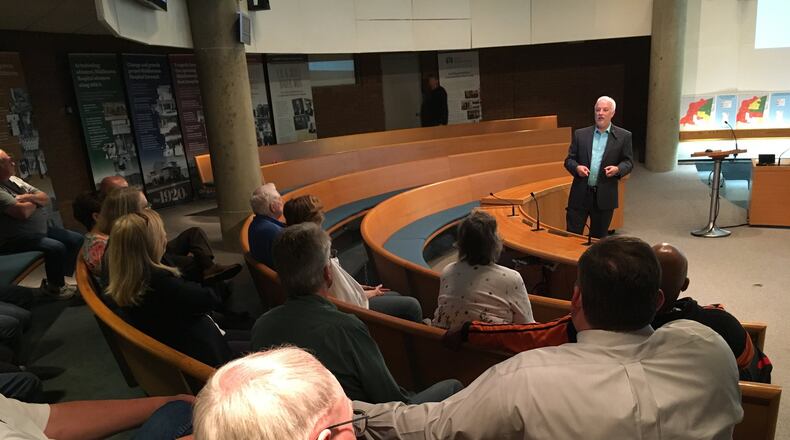Housing drives many other issues in the city, according to Adkins.
“Poor quality or low value housing tends to lock in lower income, lower educated residents,” he said, adding that limits the city’s work force development and income tax base.
“This is your livelihood,” he told nearly two dozen people — most landlords — who recently met with him. “This is part of the problem.”
From 2011 to 2015, property values in Middletown dropped 13.5 percent, according to Adkins.
“(Middletown is) no longer competitive in the southwest Ohio real estate market,” he said. “We’re going to have to take action to correct this.”
Looking at practices used elsewhere in Ohio, Adkins talked about several possible programs the city may want to adopt, including:
- taking three or four streets at a time and and completing major fix-up of infrastructure, demolishing homes in poor condition, and rehabbing or rebuilding part of the neighborhood
- not permitting water service without a background check
- re-starting the city's Housing Committee
- working with the Middletown Bar Association to develop a model lease for landlords to use
- seizing houses through the county land bank that can be rehabbed. The homes are then sold at a low price in exchange for the new owner investing their capital to make all of the improvements required to meet the building code. The new owner is given six months to make the improvements and if it passes code, they get the deed to the property. If the new owner chooses, they can sell the house by using a Middletown realtor to a new homeowner who will occupy the house as well as keep any profit from the sale.
However, demolishing housing units isn’t the only solution, Adkins said.
More than 49 percent of housing in Middletown is two bedrooms or less, according to Adkins. That means people who have larger families and want to move up to the next housing level are forced to go elsewhere.
Adkins said some developers have discussed building as many as 400 new homes with three or more bedrooms at a price point of $150,000 and higher in the Miller Ridge area and at Sawyer Mills. He said the talks are only preliminary.
Many of the landlords in attendance were supportive of Adkins’ presentation.
“I love it. I love what Doug is doing,” said Dickie Brandon. “I grew up in the Second Ward. We need better screening and home ownership.”
A local builder and investor, Brandon said he owns 78 rentals and said he’s only had to evict tenants three times over the past 20 years.
During his presentation, Adkins noted that 10 landlords filed 682 of the 1,747 eviction cases filed in 2016 in Middletown Municipal Court. One landlord, MKJAS Properties, filed 213 evictions in 2016, according to court records, he said. Adkins said there was one tenant evicted eight times in 2016, according to court records.
Adkins said the problem with rentals was not with the local landlords — the city has problems with absentee landlords who do not adequately screen tenants.
“If you give a person a good place to live, they’ll take care of it and there won’t be any evictions,” Brandon said. “We need a network of landlords to communicate with each other.”
He agreed there are some landlords that are in it for the money instead of what’s good for the city.
Adkins also said many of the city’s problem landlords are absentee landlords who do not adequately screen tenants.
Dan Tracy, who owns more than 140 rental units in the city with his daughter, said the presentation was one of “the first steps of being out of the hole.”
“We’ve come a long way in two years (since Adkins became city manager),” Tracy said. “It would be a big step if we can put this together. He’s trying to work with the community. There’s a right and a wrong way to do things and he’s trying to do it the right way.”
Tracy said he liked some of the ideas that Adkins presented to rehab several streets and homes at once.
“If we want to take back the town, we need to work with the city and the city needs to work with us,” he said. “I know Middletown is going to come back.”
BY THE NUMBERS
Median home value in Middletown dropped from $107,500 in 2000 to $93,700 in 2015
78.4 percent of Middletown’s home values are under $150,000
79.3 percent of the city’s housing was built before 1980 and 21.5 percent was built before 1939
Source: City of Middletown
About the Author

